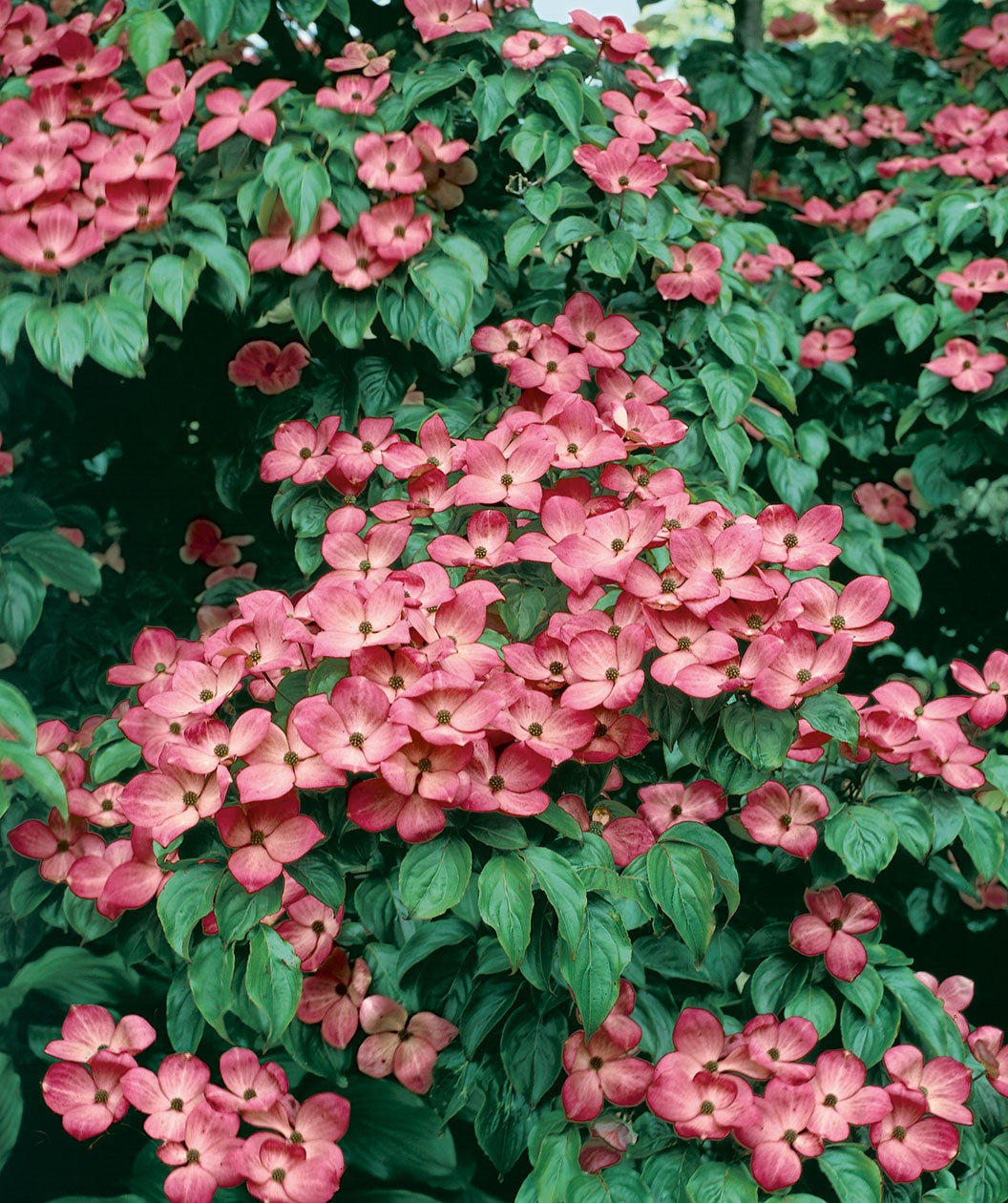



The Satomi Dogwood adds soft elegance to any landscape with its graceful shape and romantic pink blooms.
FEATURES:
-
Soft pink bracts bloom in late spring to early summer
-
Unique horizontal branching adds architectural interest
-
Glossy green foliage turns rich red in fall
-
Compact size—ideal for smaller yards or foundation planting
-
Attracts birds and pollinators
Design Tip:
Use the Satomi Dogwood as an understory tree beneath taller canopy trees or as a specimen near outdoor seating areas. Its layered branching looks stunning against evergreen backdrops or beside darker structures, where the pink blooms and fall color can really shine.
Growth Facts
- Hardiness Zone: 5-8
- Mature Height: 15-25' tall
- Mature Width: 15-25' wide
- Exposure: Full Sun/Part Shade
- Spacing: 15-25' apart
The Satomi Dogwood adds soft elegance to any landscape with its graceful shape and romantic pink blooms.
FEATURES:
-
Soft pink bracts bloom in late spring to early summer
-
Unique horizontal branching adds architectural interest
-
Glossy green foliage turns rich red in fall
-
Compact size—ideal for smaller yards or foundation planting
-
Attracts birds and pollinators
Design Tip:
Use the Satomi Dogwood as an understory tree beneath taller canopy trees or as a specimen near outdoor seating areas. Its layered branching looks stunning against evergreen backdrops or beside darker structures, where the pink blooms and fall color can really shine.
Growth Facts
- Hardiness Zone: 5-8
- Mature Height: 15-25' tall
- Mature Width: 15-25' wide
- Exposure: Full Sun/Part Shade
- Spacing: 15-25' apart
Why plant Satomi Japanese Dogwood?
Satomi Kousa Dogwood is a head-turning specimen tree that will work hard to prove it deserves that prime planting location you give it by a busy sidewalk or near your front entrance or back patio. It never has an off-season! In late spring, the starry, strawberry-milkshake-pink flowers hold court. In summer, the lush green foliage takes over and the funny Cap’n-Crunchberry-like fruits form (they’re edible and have a tropical fruit flavor). Cool weather brings spectacular purple and raspberry-red foliage to your landscape, and in winter, it’s all about the marvelous jigsaw-puzzle bark. To top it all off, being a Japanese Kousa Dogwood, Satomi is pretty much immune to the pests and diseases that can trouble other Dogwood trees!
The Japanese have been passionate gardeners for centuries, but until relatively recently, they kept their most exquisite finds to themselves. When the U.S. finally forced open the door in the 1850s, Western plants people got to see what they’d been missing. Naturalized American Thomas Hogg, Jr. was one plant explorer who rooted out new treasures for the West, including the Japanese “Kousa” Dogwood in 1875. Satomi, the first-ever pink-flowering Kousa came much later—directly from Japan. Nurseryman Akiri Shibamichi named it after his granddaughter in 1980. Satomi means “beautiful and wise.”
How to use Satomi Japanese Dogwood in the landscape?
Light to medium pink flowers appear in early summer on this gorgeous Satomi Japanese Dogwood. Dark green leaves with a tinge of red offer an awesome contrast along with attractive exfoliating bark. Burgundy-red leaves team up with large edible strawberry-like fruit in fall. All that plus exceptional disease resistance makes this Satomi Japanese Dogwood a "must have."
Planting Zones
Hardiness Zone: 5-8
How To Plant Satomi Japanese Dogwood
Satomi Kousa Dogwood is an uncommon tree, which is surprising, given how easy it is to please and how much it has to offer. This naturally disease-resistant tree enjoys a site in full sun or part shade and wants regular irrigation but no “wet feet.” It has a preference for acid soils, so if rhododendrons and azaleas grow well in your area, this is definitely the tree for you (though it’s adaptable to other situations, too).
How To Water
Water weekly, or better yet, use the Bower & Branch® Water Element to deliver just the right amount of moisture to your tree throughout the growing season.
How To Fertilize
Incorporate Elements Starter Plant food granular form into the soil when planting. If planting in spring or summer, start fertilizing late fall using Elements Starter Plant food granular form on an annual basis each late fall. Continue this for the first three years to get your plant well established.
How To Prune
As your tree grows, you’ll probably want to remove the lowermost branches to show off that amazing jigsaw-puzzle bark! Pruning is best done shortly after the flowers are spent.




